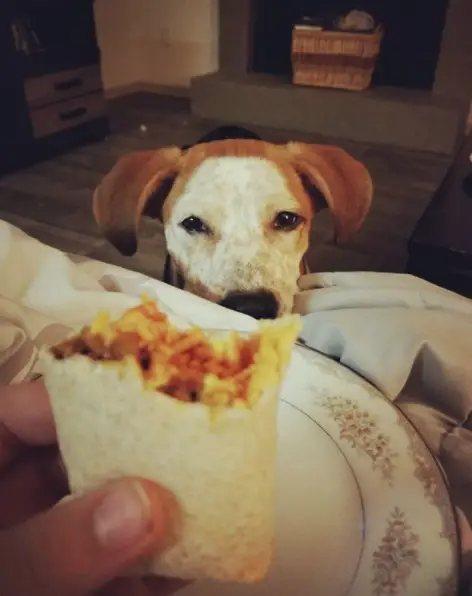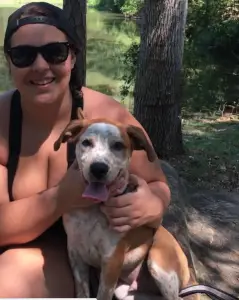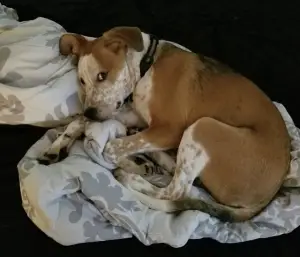
The Cost of Dog Food
 If your dog is eating a 30-pound bag of dry food every month to two months, you’ll spend about $250 a year on dog food. Upgrade that to “holistic” dry food and you’ll be spending nearly $400 a year on dog food. Some dogs can’t eat dry food and require canned or raw frozen food. If that is the case you may spend up to $1,000 a year on dog food alone.
If your dog is eating a 30-pound bag of dry food every month to two months, you’ll spend about $250 a year on dog food. Upgrade that to “holistic” dry food and you’ll be spending nearly $400 a year on dog food. Some dogs can’t eat dry food and require canned or raw frozen food. If that is the case you may spend up to $1,000 a year on dog food alone.
One way to trim down on that cost is to simply feed your pup what you are eating at home.
Homemade Dog Food
Yes! You can feed the dog table food and it is absolutely fine. In some cases, it can actually improve their health. For instance, my pup has a scrambled egg a couple times a week as a treat. This not only helps his coat come in nicely, it can also help me trim down on my overall food cost for my pup.
Similarly, after dinner, he also gets a portion of whatever meat and veggie we had (and sometimes a little potato or brown rice if he’s had no grain that day). This “extra” bit isn’t costing me anything. In fact, it is normally the leftovers that would have gotten left in the fridge for five days and tossed out anyway.
Ingredients to Avoid
If you want to make your own homemade dog food you’ll want to know what foods you should avoid. While dogs are omnivorous, meaning they enjoy meat, fruits, veggies, and grains, there are some foods we can have that they cannot. For example, grapes can be poisonous for pups. Chocolate is also a well-known no-no for dogs. Here is a list of other foods to avoid giving your pup if you’re thinking about switching to a homemade diet:
- Fats and fatty meats (this includes bacon). While bacon is delicious and your dog may even enjoy it, it is bad for them. They can actually cause pancreatitis in your dog. So, avoid feeding your dog fat from your food or bacon.
- Similarly, salty foods should be avoided as well. This is the reason popcorn and pretzels have always been on the no-no list. The salt can cause sodium ion poisoning in your dog and it can also cause excessive thirst and urination. If you’re going to make homemade dog food, be sure to separate your dog’s portion before adding salt and other seasonings.
- Skip the garlic and onions, too. Even though it will spice your meal up significantly, your pup doesn’t need the extra flavor. In dogs, onions and garlic can destroy red blood cells and, ultimately, lead to anemia.
- Dairy. Although you may slip your dog a piece of cheese here and there, you should not allow mass amounts of dairy into their diets. Many dogs are actually lactose intolerant so placing dairy into their diet can cause severe gastrointestinal issues.
- Raw meat. IF YOU WOULDN’T EAT IT, NEITHER SHOULD YOUR DOG. Don’t feed your pet raw pet. Even though their bodies are more able to process it than yours, they are still prone to E.coli and other diseases transferred through raw meat.
- Candy and some peanut butter. Many baked goods, candies and some peanut butter have an ingredient called xylitol. Xylitol causes an insane insulin surge in dogs that leads to a drop in blood sugar. If you want to share a cookie, baked treat or even peanut butter with your pooch check and make sure it is xylitol-free. (You should avoid most sugary foods with your pets.)
- Avocado. In large amounts, avocado can be poisonous to dogs. Avoid using it in any food you are preparing for them.
In addition to some of these larger mentions, you should also avoid sharing the following with your dog: uncooked yeast dough, seeds/pits from fruit, raw potato, bones, apple cores, alcohol, caffeine, and human medicine.
Start Slow
If you’re thinking about switching to a homemade dog food plan, great! It saved me a ton of money. We buy dog food every once in a while (when we go out of town and when he needs a new bag, which is not very often).
It is recommended anytime you change your dog’s diet that you start slowly. So, continue to feed your dog their dry food with some of your food (plain meat and veggies) on top. Then, each night, put a little less dry food and more of the homemade food into his/her bowl.
It should also be noted that you should not try to convert a very young or very old dog into a completely homemade diet. Many times, dogs that are not healthy adults have different dietary needs. Of course, if you have any trouble with your dog’s diet you can always reach out to your veterinarian for advice.
Have you switched your dog to a homemade dog food plan? Have you saved?